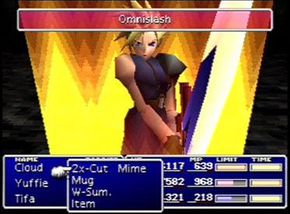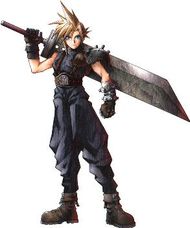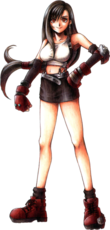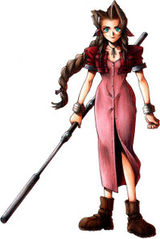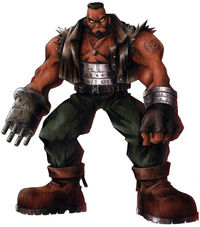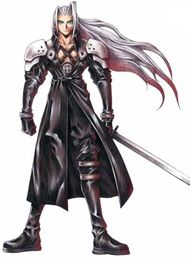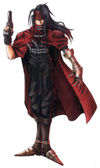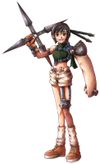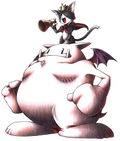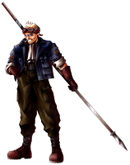Final Fantasy VII
Final Fantasy VII is a classical Japanese kabuki play. It was produced in 1797 by the Square Theatre Company and first performed at the Sony Play Station, one of the most popular stations for plays in Japan at the time. It is the seventh installment in the Final Fantasy Folio, although due to Japan's strict isolationist policies it was only the fourth play of the folio to be released in North America, and the first released in Europe.
Set in a dystopian future of steam power and almost-equal rights for women, the play was one of the first examples of science fiction kabuki in history. The play's story centers on ronin Cloud Strife who joins forces with several others to take down the Shinra Shogunate, who are draining the Great Spirit of the Planet to use as an energy source. As the story progresses, the situation escalates until Cloud and his allies face Sephiroth, a demonic shadow warrior and the play's main antagonist.
Final Fantasy VII was met with immense critical and commercial success at the time of its release, and has been described by many prominent theatre critics as the "Best. Play. Evar."
Gameplay
FFVII belongs to the role-playing genre, and despite its uniqueness it still contains many of the common hallmarks seen in similar plays before and since. One such convention is the opportunity for the audience to name the main characters. Obviously in Japan's rigid caste-based society, this honor usually fell upon the most socially revered member of the crowd – a lord or shogun – who generally named the main character after himself, and if he was feeling generous, all of the others after his friends. There were also, however, isolated examples of people not taking the play seriously, and naming Cloud and his friends things like "gayboy" and "gerald", which tended to cause great annoyance to more devout followers of the play.
As with many role-playing plays, the characters themselves also have a degree of customizability, with the audience making choices regarding the attributes and tactics of the players. Historically, the deliberately slow and measured movements of kabuki performers (called turn based by the Japanese) would invite a catcall of suggestions from the stands. Many patrons would delight in advising the fictional characters during battles for instance, where they would shout out requests for their favorite moves or tell them to "watch out behind you!"

To ease this practice, FFVII introduced the materia system. Materia were colorful orbs that were given to the audience members on the way in, and would signify to the actors what move they wanted them to perform against their enemies.
There were many different kinds of materia. Green materia were for casting magic – spells such as "Fire" and "Cure", for example – while the red materia were for summoning. There was a large choice of monsters that could be called upon to aid the party in battle, and the summon materia could also be used by horny viewers to request the company of a geisha. The only problem with this was that it left the responsibility of the story's progression in the hands of the crowd, and a series of poor decisions was all it would take to reach the game over screen, meaning all the players were dead and everyone had to go home early.
The play was also noted for the vast amount of secrets and sidequests it contained, which meant it usually warranted a second or third viewing to catch all the things you missed the first time around. Many viewers miss the scene in which the Cloud and friends meet the gothic shapeshifter Vincent for example, because it is all played out backstage in hushed voices during the interval. The battle with Emerald Weapon is another oft-overlooked scene due to the fact that it is performed all in black against a black background with the lights switched off. This led to the release of strategy guides for the play, which offer details on how to uncover these Easter eggs. The guides, however, are absurdly pricey.
Characters
The characters of FFVII were immediately popular with audiences and critics alike and have since gone on to become well known stereotypes of J-Theatre. In fact, many of them were stereotypes long before the play went into production.
Despite the large cast of characters, only three could ever participate in battle at a time. This was an unfortunate symptom of the cramped stages in Medieval Japan, which, as well as being tiny, were typically populated by an assortment of stage-hands and musicians dressed all in black. The vast size of some of the monsters didn't help matters either, particularly the bosses, which were all portrayed by sumo wrestlers.
Main
| Portrait of the original actor | Biography |
|---|---|
| Cloud Strife is the protagonist of the play, a stoic and indifferent samurai-turned mercenary, who is employed by rebels to take down the Shinra Shogunate. He is haunted by voices and visions of his past, particularly those surrounding his adventures with former ally and legendary warrior Sephiroth, and his younger days with childhood girlfriend Tifa (although the latter haunt him in a completely different way).
As the play progresses Cloud's mental state deteriorates, and we learn that his memories are falsified; that he was never actually a noble samurai or ally of Sephiroth, nor did he really know Tifa. In fact, he was a simple farmer and the only girl he'd ever seen naked had a staple through her belly. Cloud's distinguishing features include his eyes, which glow bright blue due to the magic infused in him. This is also likely the cause of his impossible, gravity-defying hairdo, which required five stagehands and an intricate pulley system to maintain onstage. He carries a disproportionately large sword almost the size of his whole body, built by legendary swordsmith Masamune, who himself went on to influence the work of Sigmund Freud. The character was a hit with young Japanese boys of the era, who adopted him as an idol despite his questionable morals, severe schizophrenia and the fact that he has square blocks for hands. | |
| Tifa Lockhart is one of the two main love interests in the play; an earnest but downtrodden woman who grew up with Cloud and is now fighting in the rebellion. Tifa is a bareknuckle fighter with impeccable martial arts skills – which are somehow never hindered by her unique centre of gravity.
The horniness of Japanese playwrights was well documented, and the "large breasted female friend" was therefore a widely known archetype of the nation's theatre. Square took this archetype further than ever with Tifa, whose absurdly big bust was comparable only to that of Lara Croft from the swashbuckling epic Tomb Raider. The first actress to play Tifa, Hitomi Tanaka, was similarly well proportioned, but many subsequent actresses have had to achieve this through props and costume. Hence the reason why theatre season in Japan always runs concurrent with the watermelon harvest. | |
| At the start of the play Aerith Gainsborough is a flower girl from the slums. All she wants is a room somewhere, far away from the cold night air, and, if possible, one enormous chair. After she joins the rebels on their journey however, we learn that she is an Ancient – the last survivor of a race of early humans who were at one with the Spirit of the Planet. She is the only hope for saving the world – using an archaic spell called which destroys all evil, including, they speculate, humanity themselves.
Along with Tifa and Cloud, she forms a love triangle which becomes the focus of much of the play's plot. The playwrights' restrictive and binary views of women meant that Aerith was designed in contrast to Tifa. With her ladylike pink dress and spiritual leanings, she was the angelic virgin to Tifa's big-titted whore. Aerith is killed by Sephiroth just as she finishes casting Holy. The scene is regarded as one of the most iconic and touching scenes in kabuki history due to the simple, undramatic way it is played out, although many patrons overlook the scene because tea is served immediately afterwards. It is said that the scene taught a whole generation of young boys to cry (when they were forced to read it in school). | |
| Barret Wallace is the leader of the rebel group that Cloud joins at the start of the play. He is steadfastly dedicated to the revolution, and has a personal grudge against the Shinra because they destroyed his hometown – a series of events that somehow led to him losing a hand and having a gun grafted on in its place. Guns at this time could only hold one bullet and took several minutes to reload, meaning Barret became somewhat of a comic relief character during battle scenes.
Black characters were rare in kabuki, and some would say they still are, making Barret an anomaly to this day. To compensate Square tried their best to avoid the usual Black clichés, instead making Barret a struggling single father with a heart of gold and a broken speech pattern. The original Barret was played by slave actor Uncle "Uncle" Tom Hughes, who was owned by the theatre. More recently, he has been played by famous TV personality Laurence Tureaud. | |
| Sephiroth is the villain of the play; a legendary samurai, powerful sorcerer and fashionista, formerly of the Shinra Shogunate, who mysteriously disappeared five years ago. According to Cloud – the only witness to the events – Sephiroth discovered he was an also an Ancient and became bent on wiping out the human usurpers of his planet. This culminates in a battle between Cloud and Sephiroth, the results of which Cloud cannot recall.
At the start of the play Sephiroth returns and is pursued across the world by both Cloud's party and the Shinra. It is discovered that Sephiroth has resumed his vendetta against humanity and intends to bring about Armageddon via a giant meteor. After getting bored of waiting for one to fall however, he goes in search of a spell to drag one from the sky. Sephiroth has frequently been called the greatest villain in legitimate theatre, and one of the best in illegitimate theatre too. Critic Joe Woods said of him, "He has all the mystery and unseen power of Sycorax from The Tempest, the ferocity of Richard III, and the fashion sense of Dr Frankenfurter from The Rocky Horror Show." |
Supporting
| Portrait of the original actor | More info |
|---|---|
| Red XIII fulfills the role of the samurai's faithful dog; a common trope in Japanese mythology. Like all animals in Japanese stories, he has the ability to talk and think rationally, outdoing many of the human characters in this respect. Traditionally he was played by an actual dog on stage, although was subtly substituted with a man in a dog costume for his dialogue scenes. | |
| The vampiric shapeshifter Vincent Valentine, originally a minor character, has become one of the most enduring icons of the play. His brooding handsomeness attracted teenage girls in droves, who would flock to the theatre with pockets full of their parents' money to empathize with his bleak life of bodily change and forced celibacy. His popularity led to him appearing in several other works, including Dirge of Cerberus, Advent Children and thousands of pages of erotic fanfiction. | |
| Yuffie Kisaragi is a mischievous young ninja who initially joins the party to steal their stuff. The reason she sticks around through the whole play is at best ambiguous, and at worst nonsensical.
Yuffie is only an "optional" character, and doesn't appear in some versions of the play. This tends to be at the director's discretion. | |
| Cait Sith is a small black toy cat riding upon the back of an enormous white toy cat. Or perhaps he is the enormous white cat, and the small black one is riding on him; it has never been fully addressed. As far as merchandising techniques go, there is none more subtle than simply having a giant plush toy walking around with the rest of the characters.
In terms of personality, Cait Sith is the "clown" or "fool" role in the play, adding nothing the progression of the story other than terrible jokes that lose all sense in translation. | |
| Cid Highwind is the uncouth, foul-mouthed captain of the party's airship, the Highwind, which is powered using the second most advanced technology of the day: helium (although in the actual play the illusion of flight is achieved by stagehands dressed like clouds). Many of Cid's best lines are ruined by the hilariously high-pitched voice he delivers them in. |
Development
One of the main things the Square Theatre Company wanted to achieve with Final Fantasy VII was a heightened realism previously unseen in kabuki. They felt the 16-bit approach, named for the sixteen bits of paper used in creating the sets, had long seen its day. In contrast to the previous plays in the series, Final Fantasy VII did not use two-dimensional paper sprites for characters, instead opting for three-dimensional human actors. This was a first for Japanese theatre at the time.
All these technical innovations made Final Fantasy VII the most expensive play ever made, which caused problems with Square's resident theatre, SNES (Super Nintendo Entertainment Showhouse). Back in the 1790s, Japanese plays were recorded on "cartridges"; large, bulky tablets of wood upon which the script for the play would be carved. These cartridges caused much annoyance for Japanese audiences due to the fact that they often got covered in dust and had to be blown clean by the actors before the play could begin. The epic story, deep characters and detailed backgrounds of FFVII contained far too much information to be printed on one of these cartridges, but Nintendo refused to try any other approach.
At the same time, a new theatre-house owned by Sony (who until now had only been known for producing phonographs) started using a disc-based system that was far superior to Nintendo's cartridges. These "discs" were smaller than cartridges but far more information could be written on them. The discs were thin circles of paper which allowed calligraphers to write large amounts of data upon them in their terse Japanese style. Square therefore ended their long and tumultuous relationship with Nintendo and moved over to Sony.
Music
The soundtrack for Final Fantasy VII was written and performed by Japanese composer Nobuo Uematsu, who also created the music for Hideo Kojima's Metal Gear series of tactical espionage plays. Each character in the play has a leitmotif, which Uematsu would sit and play in a continuous loop while that person was on stage. Using a traditional Japanese stringed instrument called a Biwa, he somehow created a bizarre cacophony of electronic blips and beeps, which critics of the era found to be hauntingly futuristic. These days, on the other hand, it is often likened to 1980s synth-pop. The original patrons were also mesmerized by the way he managed to make a small hollow piece of wood play in Stereo (although there was an option to switch this to Mono).
Notable themes from the play include "One-Winged Angel", a piece with the ambition of a grand opera but in the style of one guy playing a Yamaha home organ (which actually hadn't been invented at the time). Another is the "Victory Fanfare", which plays whenever the heroes succeed in battle – this is accompanied by several minutes of the actors standing around posing in celebration.
Reception
FFVII earned heaps of praise for its story, characters and music. It was possibly the first true blockbuster in Japanese theatre since the absurdist Super Mario Bros plays of the side-scroller era (so named for the way the backgrounds would scroll across the stage, giving the illusion of transit). Tickets sold extremely well, breaking all box office records at the time, with patrons queuing for days to get a chance to see it. Prior to the play's release kabuki only had a small following amongst teenage boys, and was considered lowbrow and geeky by society at large. With its deep, involving narrative, FFVII was the first play to gain mainstream success, and is one of the earliest cited examples for the "theatre as art" argument (an opinion that is still not widely accepted today). Publications such as IGN and TheatreSpot have called it one of the most important plays of all time. Edge magazine placed it third in their Greatest Plays poll, behind Beckett's Waiting for Godot and the cubist masterpiece Tetris.
The play has received negative criticism as well, with many critics now considering it overrated. The most common target for criticism however is its English translation, which is packed with everything from simple typos to utter nonsense, all of which only further obscure what it already a barely-comprehensible plot.
The most crucial review however was from Emperor Akihito, who called the play "extremely satisfactory". It is rumored he was more of a Nintendo-fanboy.


